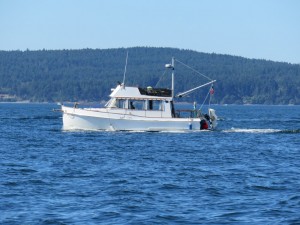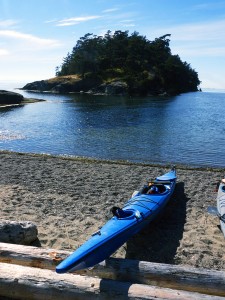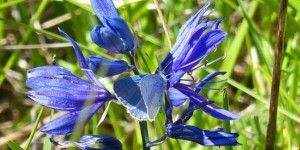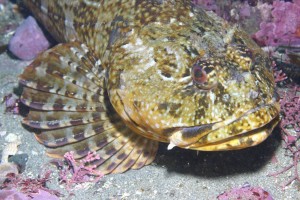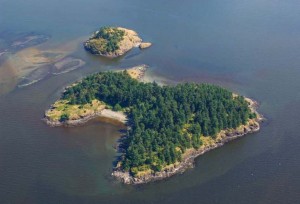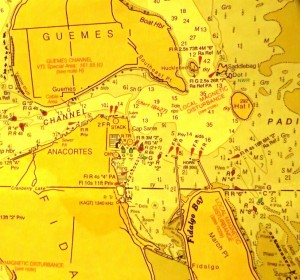An impromptu invitation to go crabbing on the north side at Saddlebag Island by a fellow boater introduced us to his favorite seafood spot. I’m no crab lover, but I enjoyed the experience of traveling the Swinomish Channel past La Conner perched high on a Grand Banks powerboat’s flying bridge. You view the environs from a totally different perspective than from a sailboat at sea level. In the photo below, the flying bridge is stationed above the inside main cabin. Grab a seat behind the short tinted windshield adjacent to the antenna and you can steer the boat from outside. And when not underway, it’s a great spot to enjoy a picnic in the sunshine!
Grand Banks trawler
Many people, especially less experienced kayakers, enjoy the short paddle from Anacortes to this popular 24-acre island shaped like a horse rider’s saddlebag. The Washington State Marine Park is located two miles northeast of town and was identified by the Wilkes Expedition of 1841 as one of the “Porpoise Rocks.” Kayakers have a choice of launch sites: Guemes Island ferry terminal, Cap Sante Park, or Bay View State Park, the latter during higher tides. Of course, there are other private launch sites that can be recommended. An example is Fidalgo Bay Resort. From any of these locations, especially in Guemes Channel, be sure to watch your tides and currents.
Photo credit: Wikimedia Commons
Access to Saddlebag Island is best from the north cove with its low-lying beach, protection from wind, and secure anchorage. This is where we anchored and proceeded to spend the afternoon deploying his pots to catch our limit of Dungeness crab.
Photo credit: Wikimedia Commons
Saddlebag Island has five primitive campsites. One of them is part of the Cascadia Marine Trail. It is designated for the exclusive use of those arriving by human- or wind-powered watercraft. Everyone who camps must bring their own water and pack out whatever they bring with them. A composting toilet is available.
Shooting Star – Photo credit: Mike Viouri of the National Park Service
One of the nice things about hiking the perimeter trail on a small island, it is hard to get lost! During April and May, a wide variety of beautiful wildflowers bloom here, much sooner than other meadows in the San Juan Islands. And Padilla Bay at the island’s eastern edge is a National Estuarine Sanctuary known for attracting an abundance of wildlife. One of those creatures is the river otter shown below in this photo.
River otter – Photo credit: Wikimedia Commons
Nearby Dot Island is a bird sanctuary and stepping ashore isn’t permitted. However, it is legal to hike on Huckleberry Island, though it is difficult. Crabbing and fishing are reported to be excellent around all three islands, but you do need to obtain a license. Cabezon prefer Saddlebag’s western side, Lingcod and Greenling swim around Huckleberry Island, and Flounder and Sole inhabit the shallow water east of Dot and Saddlebag islands.
Cabezon – Photo Credit: Wikimedia Commons
Come explore Saddlebag island on the doorstop of Anacortes, Washington and experience a taste of what the San Juan Islands located west across Rosario Strait offer visitors.
“Oh, taste and see that the Lord is good; Blessed is the man who trusts in Him!” (Psalm 34:8 – NKJV)
Thanks for reading!
Blessings,
Deb

